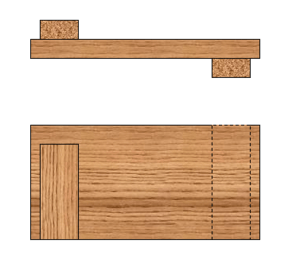Bench hook
A bench hook is a workbench accessory used in woodworking to hold workpieces in place.

Using the force of the tool being used and gravity, bench hooks can make handsawing safer and more accurate, without needing to use a vise.
Construction
Most bench hooks have three components: a bed, a fence, and a hook. The bed is the flat part of the appliance that the workpiece is placed on top of; the fence is the part the workpiece is pushed up against; and the hook is the part that is in contact with the front edge of the bench-top (see diagram to the right).[1]
Traditionally, bench hooks were made using a single piece of wood.
To complete cuts without scarring the workbench surface, the fence should be shorter than the width of base and offset from one edge.
When constructing a bench hook for someone who is left-handed, the fence should be offset from the left side of the bed.
Use
In use, the bench hook is laid flat over the bench, with the hook hard up against the front edge of same. With the workpiece thus firmly held against the stop, is easy to see that no clamps or other mechanical fixing are required, the wood being held in place by the combined pressure of the tool (a saw generally) and the hand.
Bench hooks are meant to be an aid commonly used with hand tools, such as the backsaw, a hand plane and, somewhat less frequently, a chisel of some kind. Although very simple to make, commercially made bench hooks have become increasingly available.
See also
- Bench dog: a bench dog is used for holding a piece of wood up against the stop so it doesn't move.
- Workbench: a table used by woodworkers to hold workpieces while they are worked by other tools.
References
- "Jig Journal: Bench Hook". Popular Woodworking Magazine. 2007-11-01. Retrieved 2020-04-12.